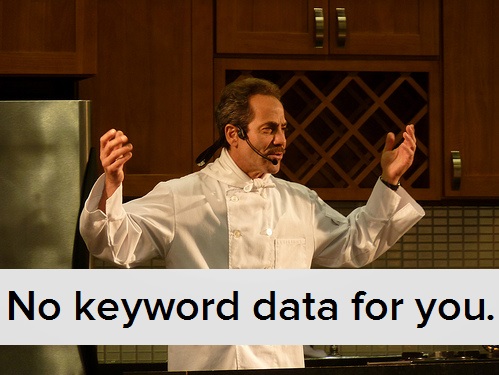 Last week, we reviewed how
Google's recent change of using SSL to encrypt search traffic has affected the analytics data
available to marketers. But that's just one part of the whole story. It's also very important to determine how much of your organic search traffic is now unidentifiable and understand how to handle those circumstances. Google ostensibly made this change to provide additional privacy to its users; however, this is also at the very dear cost to many marketers of understanding how their visitors are finding their website. While Google's truthfulness and rationality are up for debate, we are doing additional research to better understand how this change impacts the typical web marketer who is working to grow his/her business and generate leads.
Last week, we reviewed how
Google's recent change of using SSL to encrypt search traffic has affected the analytics data
available to marketers. But that's just one part of the whole story. It's also very important to determine how much of your organic search traffic is now unidentifiable and understand how to handle those circumstances. Google ostensibly made this change to provide additional privacy to its users; however, this is also at the very dear cost to many marketers of understanding how their visitors are finding their website. While Google's truthfulness and rationality are up for debate, we are doing additional research to better understand how this change impacts the typical web marketer who is working to grow his/her business and generate leads.
The Impact of Google's SSL Change on Keyword Diversity
In addition to our published research last week, we did an additional survey of HubSpot customers and analyzed our own website's data to look at the number of traffic-producing keywords they received before and after this change. This is a valuable number, because it helps give clarity to the success of your inbound marketing strategy and long-tail keywords. Websites that are executing inbound marketing and content creation successfully will receive visits on many different keywords, especially similar variations of long-tail keywords for which they've optimized their website and blog. The intelligence derived from these visits drives future content production and optimization efforts, and so it repeats. When Google takes away this intelligence, an inbound marketer's job becomes dramatically more difficult.

In our sample of websites using HubSpot's
marketing analytics tools
,
the average HubSpot customer is now receiving traffic on 16.19% fewer keywords
than in the month before this change. The amount of traffic that they receive is similar in that time period, but many of the visits are now lumped into the "Not Provided" bucket.
To clarify our sample and methodology, we examined 50 HubSpot customers who receive significant traffic from organic search (defined as at least 2,000 visits a month from organic search alone), as well as HubSpot's own website and blog. All of these websites were also in the data sample that we reviewed last week on the blog . All statistics were calculated at a 95% confidence interval. To determine the difference, we examined their traffic from the first seven business days of October and the first seven business days of November, and we made sure that they received similar amounts of organic search traffic (within 10% of each other) during each time. This way, we could be certain that the data wouldn't be influenced by big announcements or seasonal shifts that could radically alter their data. We then recorded the number of different keywords that the website received traffic from in the first seven business days of October vs. the same for November. The maximum difference seen was 40.04% fewer keywords, where the average was 16.19% fewer keywords. The standard deviation was 11.33% with a confidence interval of 1.07%, meaning that about 68% of websites received traffic from between 4.86% and and 27.52% fewer keywords than they did in the same time in October.
How Google's SSL Change Penalizes Websites With Keyword-Diverse Content
This change also appears to penalize websites that produce more content on more keyword variations, as they have more opportunities to lose out on that long-tail. Those keywords may only drive one or two visits a month each but together represent many thousands of visits. For one extreme example of this, the HubSpot blog received traffic on 8,082 different keywords in the October period of time, but on only 4,846 in the November period . This decrease of over 40% of our keywords for the blog is having a dramatic impact on how we review, plan, and think about the content we produce for our visitors and subscribers.
Here's how to review these changes for yourself and analyze the impact on your keyword strategy:
For HubSpot Customers
If you're a HubSpot customer, open up your Sources report , set it to 'Organic Search,' and then set the date range to an early October time period (like the first 7 business days). Scroll to the bottom of the organic search section, and record the number of keywords you received traffic from. Then do the same for November, and inspect the difference. The number is presented at the very bottom next to the 'Export' button in HubSpot, like in this image:

For Google Analytics Users
If you're a Google Analytics user instead, select one time period and then navigate to Traffic Sources -> Sources -> Search -> Organic . Inspect the number at the bottom, right-hand corner of the data table. Then repeat for the other time period you are interested in. Try to keep the time periods similar (e.g. use the same number of business days if your traffic arrives primarily during the week), and measure the difference. This can help you understand exactly how Google's change to using SSL for some searchers is impacting your keyword intelligence.
Marketers: What Now?
We will continue to analyze this data and the impact it has on marketers as this continues and we are able to better study the impact it has on websites. It is clear that the the SSL search change has had a major impact on how marketers are able to measure their organic search success , and it is very important for marketers to understand the change and what it means for their business and its website.
Have you noticed a significant loss of keyword intelligence? Tell us about it in the comments below.
Image Credit:
Search Engine People Blog







